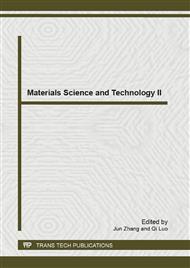p.84
p.89
p.94
p.98
p.103
p.109
p.113
p.119
p.127
Study on Preparation and Properties of Hyperbranched Polyurethane/Multi-Walled Carbon Nanotubes Composites
Abstract:
With the Grafting to method, the hyperbranched polyurethane/multi-walled carbon nanotubes composites (MWNT-HBPU) was prepared. The reaction mechanism was covalently grafting hyperbranched polyurethane to multi-walled carbon nanotubes,through the reaction of the isocyanate groups of multi-walled carbon nanotubes (MWNT-NCO) and the hydroxyl groups of homemade hyperbranched polyurethane (HBPU). The structure and properties of the composites was studied by Fourier transform infrared spectroscopy (FT-IR), Raman spectroscopy (Raman), Thermal gravimetric analysis (TG) and Differential scanning calorimetry (DSC). The test results of FT-IR and TG showed that the prepared product was MWNT-HBPU; the DSC results demonstrated that the glass transition temperature of HBPU was significantly increased from 91.9°C to more than 99.7°C by the addition of MWNT-HBPU; the dispersion of the MWNT-HBPU was much better than the pure MWNT in solvents, such as N, N-dimethylformamide , Dimethyl sulfoxide etc.
Info:
Periodical:
Pages:
103-108
Citation:
Online since:
July 2013
Authors:
Price:
Сopyright:
© 2013 Trans Tech Publications Ltd. All Rights Reserved
Share:
Citation:


